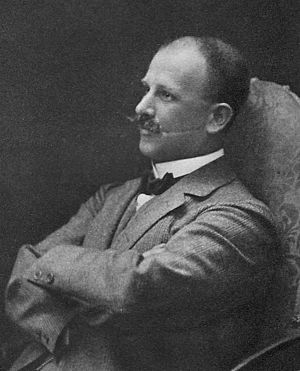Richard Abegg facts for kids
Quick facts for kids
Richard Abegg
|
|
|---|---|
 |
|
| Born | 9 January 1869 |
| Died | 4 April 1910 (aged 41) |
| Nationality | German |
| Alma mater | University of Kiel University of Tübingen University of Berlin |
| Known for | Abegg's rule |
| Scientific career | |
| Fields | Chemist |
| Institutions | University of Göttingen University of Stockholm University of Breslau |
| Doctoral advisor | August Wilhelm von Hofmann |
| Doctoral students | Clara Immerwahr |
| Signature | |
 |
|
Richard Wilhelm Heinrich Abegg (born January 9, 1869 – died April 3, 1910) was an important German chemist. He was a pioneer in understanding how atoms connect, which is called valence theory.
Abegg suggested that the biggest difference between how an element can gain or lose electrons is usually eight. This idea is now known as Abegg's rule. He was also very keen on gas balloons. Sadly, this hobby led to his death at age 41 when his balloon crashed.
Richard Abegg earned his PhD on July 19, 1891, from the University of Berlin. He studied with August Wilhelm von Hofmann, learning about organic chemistry. A year later, he started researching physical chemistry with Friedrich Wilhelm Ostwald in Leipzig. Abegg also worked as an assistant to famous scientists like Walther Nernst and Svante Arrhenius.
Abegg made discoveries about how freezing points change when things are dissolved in liquids. He also predicted an idea similar to Gilbert Newton Lewis's octet rule. This rule explains that elements often have a difference of eight between their lowest and highest electron states. He studied many areas of physical chemistry, including freezing points and how electricity moves through ice.
About Richard Abegg's Life and Studies
Richard Abegg was the son of Wilhelm Abegg and Margarete Friedenthal. His brother, also named Wilhelm Abegg, became an important government official. Richard went to Wilhelm High School in Berlin. He then studied chemistry at the University of Kiel and the University of Tübingen. He finished his studies at the University of Berlin, where he earned his doctorate.
In 1895, he married Line Simon, who also loved ballooning. Richard Abegg enjoyed photography and going on balloon trips. He started and led the Silesian Club for Aeronautics in Breslau. He was also an important member of the German Air Sailors' Association.
On April 3, 1910, Abegg flew his balloon from Breslau to Köslin. During landing, the balloon's basket got stuck in some bushes. Richard was thrown out and hit his head. He died early the next morning from a skull fracture.
Richard Abegg's Work in Science
Richard Abegg also served in the military. In 1891, he became an officer in the German Reserves. In 1900, he became a higher-ranking officer. That same year, he took his first balloon flight for military purposes. Balloon flights became a regular hobby for both Richard and his wife. He made many scientific observations during these flights, but they were never published.
In 1894, Abegg worked as an assistant to Walther Nernst. Nernst was one of the scientists who helped create the field of physical chemistry. In 1897, Abegg became a chemistry professor at the University of Breslau. Two years later, he was promoted. Clara Immerwahr, who was the first wife of another famous chemist, Fritz Haber, studied and graduated as his student. In 1909, Abegg became a full professor. He worked with his colleague Guido Bodländer to study electro-affinity, a new idea in inorganic chemistry.
Abegg is most famous for his work on valence. This is about how atoms connect to each other. He noticed that some elements did not easily combine to form molecules. He realized that these more stable elements had what are now called full electron shells. He explained that atoms are attracted to each other because of opposite electrical charges.
He also made a difference between "normal valence" and "contravalence." He found that if you add these two types of valence together, the sum is always eight. This important idea is now known as Abegg's rule.
From 1901 until he died, Abegg was the editor of a science magazine called Zeitschrift für Elektrochemie.
See also
 In Spanish: Richard Abegg para niños
In Spanish: Richard Abegg para niños
- Abegg's rule
- Valence (chemistry)

